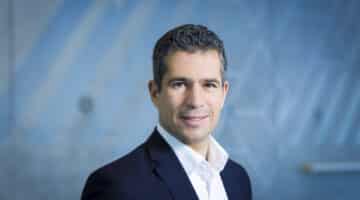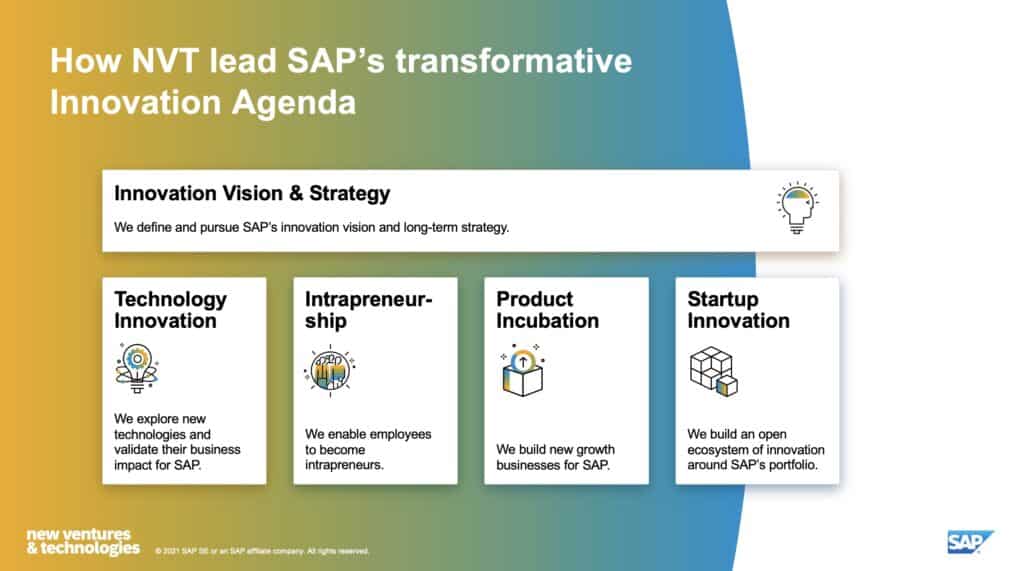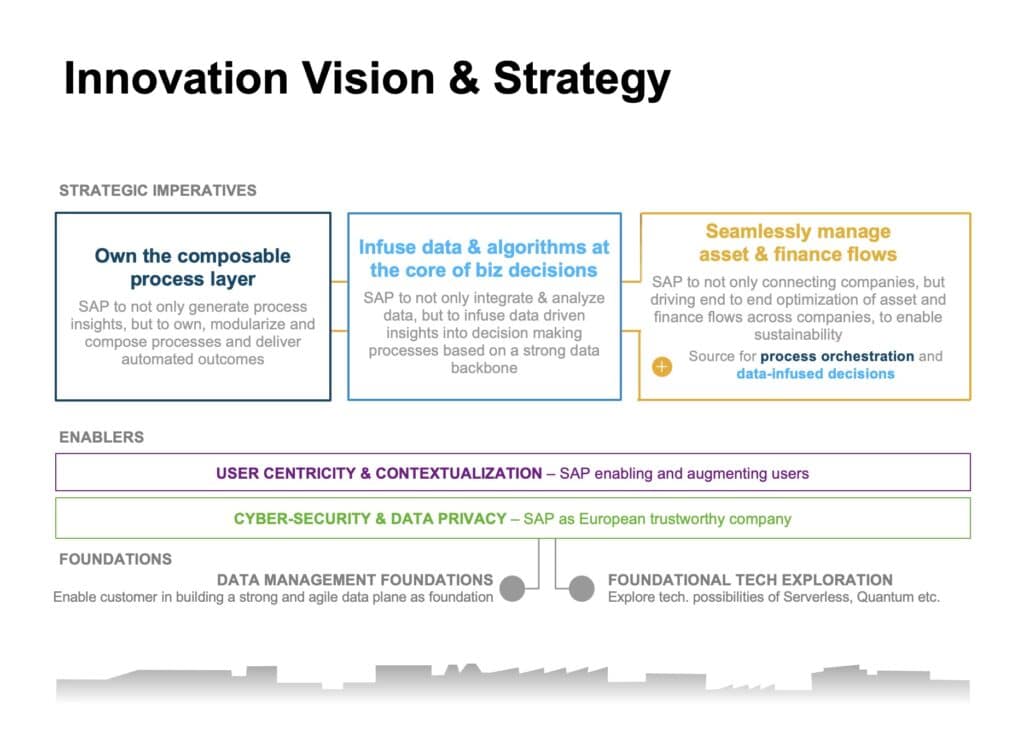The start of Martin Heinig’s career was marked by a formative experience at a company that no longer exists today. As a young working student at radio manufacturer Blaupunkt, he observed firsthand how an established company, the inventor of the car radio, toppled from its perch as market leader due to technological disruption and ultimately went bankrupt.
“Only because they failed to recognize the signs of the times,” says Heinig. “It was sad to watch and terrible for the workforce. People asked themselves, ‘How could that happen to our company in particular?’ That bothered me for a long time. Could we have prevented this downfall? And if so, when and how should we have changed course?”
Today, a decade and a half later, Heinig heads the New Ventures and Technologies area at SAP. It explores this very question, which is more relevant than ever for many companies around the world: how can a successful company stay innovative and manage its own technologies and business models with an eye to the future?
The Road to SAP
“I’d be exaggerating if I said that my experience at Blaupunkt predetermined the direction my career would take,” says Heinig. “But the company did have a certain influence on my family and my life.” Heinig’s parents met each other for the first time at Blaupunkt, after his mother moved to Germany from Turkey as a young woman. Heinig grew up in a village near Hildesheim in Germany, but he regularly spent his summers in Turkey.

“My mother’s family is from Ankara, so I grew up bilingual, which I always saw as a great advantage,” says Heinig, who was the first in his family to earn a doctorate. “Education was important to my parents, but they never checked whether I did my homework. They didn’t have the time for that. It was simply understood: if you want to achieve something, you have to do the work.”
That meant a high level of personal responsibility from the start, but also the freedom to decide what he wanted to do with his life. “It all started with a Schneider PCP, followed by an Amiga 500, and later I decided to major in business informatics at the University of Göttingen because IT was what interested me the most and what promised to be the most fun.”
Heinig spent a semester abroad in Paris, so he speaks pretty good French in addition to German, Turkish, and English. After earning his master’s degree, he worked as a software developer for two years before starting a dissertation at TU Hamburg on the use of virtual and augmented reality (VR/AR) in manufacturing. Towards the end of this four-year doctoral phase, Martin accepted a position at the newly founded SAP Innovation Center Potsdam and moved to Berlin.
He laughs at the memory: “Colleagues, fellow students, practically everyone I knew asked me if I was really sure that joining SAP would be a sensible step in my career.”
“But I was sure,” says Heinig. “There was a real pioneering spirit at SAP Innovation Center Potsdam. Everyone was full of ideas and creative drive.”
From SAP Innovation Center Network to New Ventures and Technologies
This first of what has become nine innovation centers worldwide today was led at the time by Dr. Juergen Mueller, who is now a member of the Executive Board of SAP SE and chief technology officer. Over the next few years, the seed in Potsdam grew into SAP Innovation Center Network, which serves as a kind of trend radar and think tank for SAP and is now part of Heinig’s New Ventures and Technologies domain.
“Back then, we liked to use the metaphor of SAP as an oil tanker – and SAP Innovation Center Network was a speedboat,” says Martin. “We wanted to be agile and flexible, try out new technologies and ideas, but also be able to drop them effortlessly if it became apparent that they wouldn’t go anywhere.”
Martin says one of the most important lessons he learned from this time was that think tanks have to be well connected with product departments and maintain regular contact with the lines of business.
“That’s a cornerstone of our work in New Ventures and Technologies today, too,” he explains. “How can you establish early collaboration with the lines of business to enable them to incorporate new technologies, solutions, and products?”
Having served as director of SAP Labs Berlin since August 2018, Heinig was appointed head of New Ventures and Technologies in February 2021. His years of experience as COO under Juergen Mueller served him well here: “Seizing the reins, setting the agenda myself, that part was new for me. But I was already familiar with all the topics from my support role.”
In addition to SAP Innovation Center Network, a number of other SAP departments also belong to New Ventures and Technologies.

“They all work on innovation and new technologies in some way,” says Heinig, “but each has a different focus and different partners within the SAP ecosystem. We’re not a line organization. There are many different functions in our organization, which I had to learn about in detail as the new head before I could assemble my leadership team and we could define a strategic framework together that everyone could identify with and find their place in.”
A Vision of Innovation
In this forward-looking approach, all departments within New Ventures and Technologies were involved and asked for their perspectives. “This inclusive method proved to be very important to the success of the agenda,” says Heinig. “You can’t just politely ask the employees to be innovative. The ideas need to fit with SAP’s portfolio and strategy as smoothly as possible, as both continue to evolve in the future.”
Instead, the team focused on defining the right vision of innovation for SAP. “What might our future look like and where do we want to go?” were the most important questions, according to Heinig. “And then to think back from there: what steps will get us there, what issues do we need to resolve, and what needs to happen for us to be able to resolve them?”

Three core units are responsible for anticipating major changes, in harmony with the current SAP strategy and product portfolio.
Heinig explains: “First of all, we envision the next level of the ERP systems as a kind of platform that makes it possible to put business processes and individual functions together as needed. As such, this composability architecture is a key focus of our current work, with which we want to empower our customers to use subprocesses as individual modules.”
The second development involves the handling of data. “Instead of the current usual method of displaying and analyzing data in a dashboard that you defined yourself beforehand, it will be possible to involve the system in this selection in future,” Heinig says. The magic word here is ‘contextualization.’ “Systems will evolve to the point where they can recognize my current context as a user and supply me with information on their own accord, without me having to request it explicitly,” he adds.
In addition, the Finance and Accounting area and its standards and KPIs for steering business will change. “As we see it, sustainability aspects have to be given much greater weight in reporting,” says Heinig. “To achieve this, we need a separate accounting system and sustainability KPIs have to be integrated in the SAP core system.”
A Culture of Trust and Transparency
With nearly 300 full-time employees and a large number of students, New Ventures and Technologies consists of 10 branch offices worldwide. Martin’s goal for this teamwork is to establish a culture of personal responsibility. Instead of simply assigning topics, the responsible employees should be empowered to develop them on their own.
“The most important thing is a relationship of mutual trust,” he says. “I often talk about budget issues in team meetings and provide information about my own work. Other department heads in New Ventures and Technologies do likewise.” Knowledge transfer among the different teams is also important. “Everyone has to understand that we can only succeed if we all work together and collaborate closely with one another,” he adds.
This culture of transparency is deeply rooted in SAP Innovation Center Network, but it’s also a sign of the times, according to Heinig. “We’re living in the age of the platform economy, which simply demands this transparency and strong networking among us as prerequisites for collaborative work.”
And that’s a good thing. “Ultimately, the ideas of the employees will always be the decisive factor when it comes to keeping a company in shape for the future,” he emphasizes.
As he sees it, the role of management here is to create structures that give employees the space to exercise this creativity and develop these ideas. “It starts with me as a manager, giving my employees the impression that they are allowed to express their thoughts and submit their ideas for consideration,” Heinig says. “Encouraging this openness might be my most important responsibility as head of New Ventures and Technologies – and it’s also the thing makes me like this role so much.”



